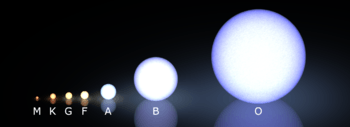HD 150248
| Observation data Epoch J2000 Equinox J2000 | |
|---|---|
| Constellation | Scorpius |
| Right ascension | 16h 41m 49.80149s[1] |
| Declination | −45° 22′ 07.4106″[1] |
| Apparent magnitude (V) | 7.02[2] |
| Characteristics | |
| Spectral type | G3V + ?[3] |
| U−B color index | +0.17[2] |
| B−V color index | +0.68[2] |
| Astrometry | |
| Parallax (π) | 37.54 ± 0.50[1] mas |
| Distance | 87 ± 1 ly (26.6 ± 0.4 pc) |
| Details | |
| Mass | 1.020 M☉ |
| Temperature | 5,723[4] K |
| Metallicity [Fe/H] | −0.04[4] dex |
| Age | 6.2 Gyr |
| Other designations | |
| Database references | |
| SIMBAD | data |
HD 150248 is a Sun-like star 88 Light-years (26.9809 parsecs) from the Sun. HD 150248 is a G-type star and a near solar twin. HD 150248's photometric color is also very close to that of the Sun; however, it has a lower abundance of metals, and has an apparent visual magnitude of 7.02. At 6.2 billion years old, this star is 2.6 billion years older than our Sun and has passed the stable burning stage. HD 150248 is found on the border between the constellations Scorpius and Ara.
To date, no solar twin with an exact match to that of the Sun has been found. However, there are some stars that come very close to being identical, and thus considered solar twins by the majority of the public. An exact solar twin would be a G2V star with a 5,778K temperature, be 4.6 billion years old, with solar metallicity, and a 0.1% solar luminosity variation.[5] Stars with an age of 4.6 billion years, such as our Sun, are at the most stable state. Proper metallicity and size are also very important to low luminosity variation. [6][7][8]

Comparison to the Sun
| Identifier | J2000 Coordinates | Distance (ly) |
Stellar Type |
Temperature (K) |
Metallicity (dex) |
Age (Gyr) |
Notes | |
|---|---|---|---|---|---|---|---|---|
| Right ascension | Declination | |||||||
| Sun | — | — | 0.00 | G2V | 5,778 | +0.00 | 4.6 | [9] |
| HD 150248 [10] | 16h 41m 49.8s | –45° 22′ 07″ | 88 | G3V | 5,723 | −0.04 | 6.2 | [4] |
See also
References
- 1 2 3 Van Leeuwen, F. (2007). "Validation of the new Hipparcos reduction". Astronomy and Astrophysics. 474 (2): 653. Bibcode:2007A&A...474..653V. doi:10.1051/0004-6361:20078357.
- 1 2 3 Przybylski, A.; Kennedy, P. M. (1965). "Radial velocities and three-colour photometry of 166 southern stars". Monthly Notices of the Royal Astronomical Society. 131: 95. Bibcode:1965MNRAS.131...95P. doi:10.1093/mnras/131.1.95.
- ↑ Gray, R. O.; Corbally, C. J.; Garrison, R. F.; McFadden, M. T.; Bubar, E. J.; McGahee, C. E.; O'Donoghue, A. A.; Knox, E. R. (2006). "Contributions to the Nearby Stars (NStars) Project: Spectroscopy of Stars Earlier than M0 within 40 pc-The Southern Sample". The Astronomical Journal. 132: 161. arXiv:astro-ph/0603770
 . Bibcode:2006AJ....132..161G. doi:10.1086/504637.
. Bibcode:2006AJ....132..161G. doi:10.1086/504637. - 1 2 3 Porto de Mello, G. F.; da Silva, R.; da Silva, L.; de Nader, R. V. (March 2014). "A photometric and spectroscopic survey of solar twin stars within 50 parsecs of the Sun; I. Atmospheric parameters and color similarity to the Sun". Astronomy and Astrophysics. 563: A52. arXiv:1312.7571
 . Bibcode:2014A&A...563A..52P. doi:10.1051/0004-6361/201322277.
. Bibcode:2014A&A...563A..52P. doi:10.1051/0004-6361/201322277. - ↑ NASA, Science News, Solar Variability and Terrestrial Climate, Jan. 8, 2013
- ↑ University of Nebraska-Lincoln astronomy education group, Stellar Luminosity Calculator
- ↑ National Center for Atmospheric Research, The Effects of Solar Variability on Earth's Climate, 2012 Report
- ↑ Most of Earth’s twins aren’t identical, by Ethan on June 5, 2013
- ↑ Williams, D.R. (2004). "Sun Fact Sheet". NASA. Retrieved 2009-06-23.
- ↑ HD 150248 at SIMBAD - Ids - Bibliography - Image.